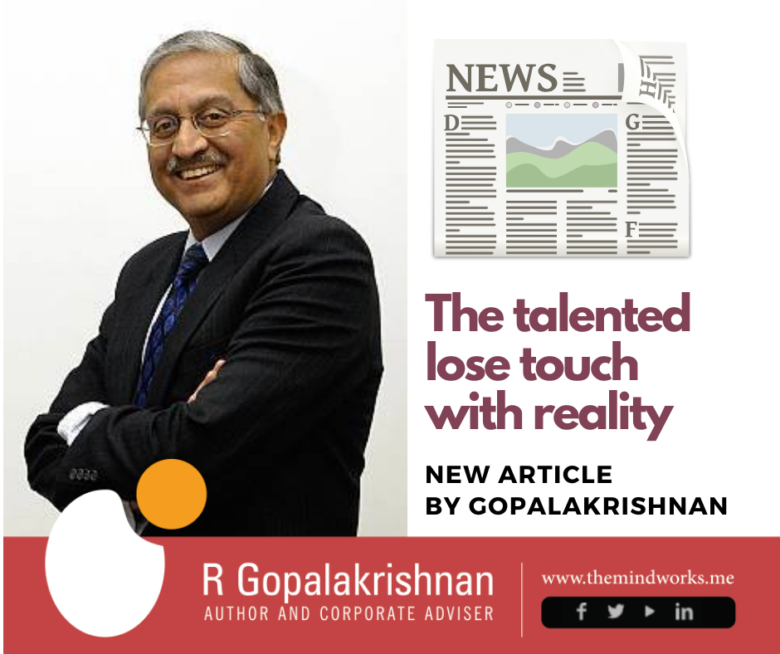R. Gopalakrishnan*
Email: rgopal@themindworks.me
(*The writer is an author and corporate advisor. He is Distinguished Professor of IIT Kharagpur. He was Director of Tata Sons and Vice Chairman of Hindustan Unilever).
Transformation is intended to do good things at the right time and in the right way. How do leaders judge that things are going well while embarking on organizational transformation? They must learn to listen to the subsonic echoes in the organization. It helps to correct course.
When one views organizational transformation, the question arises about how a leader can know that course correction is required. My answer is that leaders should listen to the subsonic echoes from the cliffs of their organization. Each organization has a unique geology, conditioned by its history and culture. The leader must understand the unique contours of the organization and must let subsonic signals influence decisions and executive actions. This is difficult. An allegory explains the reason effectively.
The great pigeon race
On June 29, 1997, a race was held to celebrate the centenary of the Royal Pigeon Racing Association. More than 60,000 homing pigeons were released at 6.30 a.m. from a field in Nantes, Southern France, flying to lofts all over southern England 400 to 500 miles away. By 11.00 a.m., most of the racing birds had made it out of France and were over the English Channel. They should have arrived at their lofts by early afternoon. They did not, and the death of so many pigeons was a disaster.
A researcher at the US Geological Survey, Jonathan Hagstrum, proposed a novel explanation. At 11 a.m., when the racing pigeons were crossing the Channel, a Concorde supersonic airliner was flying along the Channel on its morning flight from Paris to New York. Such a plane generates a subsonic shock wave–a carpet of sound almost a hundred miles wide. The pigeons, which navigate by hearing subsonic sounds, lose their bearings.
In every organisation, there are edges and cliffs from which sound reflections of the transformation emanate. Those echoes are faint, but the astute manager must strain to catch the message. Leaders must listen to this infrasound to avoid losing their orientation—like the pigeons did in the race.
The evolution of liberalisation in India is instructive. The thinking and planning really started during Indira Gandhi’s tenure in 1980 but was rudely interrupted by her death. Her son Rajiv who stepped into her shoes gave it a fresh face but got enmeshed in controversy. When the late P.V. Narasimha Rao became prime minister in June 1991, reform enthusiasts wanted him to go for the Big Bang approach, such approaches usually being very visible. He chose the middle path, which he in fact articulated at the Tirupati Congress. He reaffirmed his commitment to Nehru’s ideas, even though he would approve a completely different course of action a short while later.
Another example. Operation Flood, which ushered in a milk revolution in India, owes some fillip to a visit by Prime Minister Lal Bahadur Shastri to Anand in the 1960s. He desired that instead of staying at the house of Dr Kurien, there being no hotels or guesthouses in Anand, he would rather spend the night at the house of a farmer in Kaira district. This caused consternation among security personnel, and logistical complications for the administration.
To keep it a secret, one village farmer was initially told that two foreigners would stay with him; only at the last minute was he told that the guests would be the Prime Minister and the Gujarat chief minister. Shastriji had an early dinner with the nervous farmer and then went around the village talking to the people. Most of the villagers kept awake as Shastriji enquired and visited the colony of Harijans, Muslims and all the others. At each place, he enquired about the milk cooperative of which they were members. This went on from 8 p.m. to 2 a.m.
Next morning, he asked Kurien to explain the secret of Amul’s success, whereas nowhere else in the country had cooperatives worked. Kurien explained the ground realities succinctly. Shastriji had heard what he could not have gathered in many seminars sitting in Delhi. It was a unique way for a modern leader to listen to the infrasound of what mattered to dairy farmers.
Authority and the trappings of power conspire to plug the leader’s ears. Listening carefully is such an elementary lesson, why does one have to explain its importance? Precisely because it is elementary, and life’s mistakes are made by ignoring elementary things!
Leo Tolstoy wrote in Anna Karenina ‘All happy families resemble each other, but each unhappy family is unhappy for its own reasons’. Likewise, all change management cases resemble each other, but each one is unique to the prevalent culture, beliefs, and mindsets. Listening carefully to the unique infrasound of the organisation is a valuable tool.
*(R. Gopalakrishnan is an author and corporate advisor. He had served as Director, Tata Sons and, before that, as Vice Chairman, Hindustan Unilever. In a research collaboration between a practitioner and academics of SPJIMR, Mumbai, he has co-authored six books on Shapers of Business Institutions, covering HDFC Group, Kotak Bank, Marico, Biocon, L&T and TCS)

